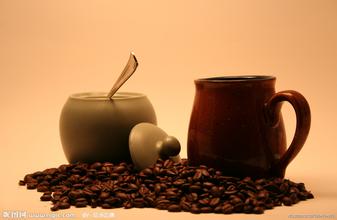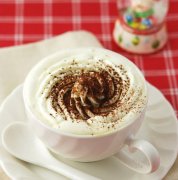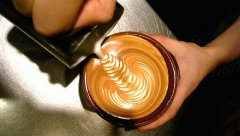The standard of coffee taste describes the type of dry aroma.
1. Olfaction (sense of smell): each kind of coffee has a unique smell (bouquet), which distinguishes coffee from different producing areas or species. A, Dry aroma/ fragrance- dry aroma; coffee grinding before brewing dry coffee powder aroma B, Cup aroma/ aroma- wet aroma; coffee brewing, the liquid surface of the aroma C, Nose- coffee after the entrance of the nasal smell of Ding, Aftertaste- taste; coffee swallowed, the taste remaining on the taste buds
Types of dry aroma: sweet flower flavor, sweet fruit flavor wet aroma: fruit flavor, herbal flavor after entrance nasal aroma (nose): caramel, nutty, wheat aftertaste (aftertaste): carbon flavor (similar to photocopier document flavor), chocolate, spice, turpentine / camphor flavor

Each flavor requires further description of the intensity Rich, Full, Rounded, Flat and the corresponding details. Complexity is different from miscellaneous flavor. Complexity refers to the synthesis of good qualities in coffee, while miscellaneous flavors are unpleasant flavors in coffee, such as coke, wood (old beans), grass (new beans), even rubber, or iodine.
2. Gestation (taste): taste evaluation is for the taste of water-soluble substances in coffee. Contains organic (such as carbohydrates / sugars, vegetable oils, fruit acids, etc.); tastes range from slightly sweet to extremely sour. Organic compounds include alkaloids (such as caffeine and esters) and non-organic substances that cause bitterness. Non-organic compounds include mineral salts that cause bitterness and may cause tastes from sweetness to astringency, soapy to metallic. The basic taste feelings include: sour, sweet, bitter, bitter. (During the coffee cupping), when tasting light roasted coffee, bitterness only serves as a complementary or enhanced description of the other three tastes, but bitterness becomes the main taste description when evaluating deep-baked coffee. Bitterness is one of the disgusting feelings. But sometimes bitterness can add points to the senses of food. Bitter but delicious foods include dark chocolate, beer, and grapefruit. The disappearance of bitterness will reduce the appreciation and evaluation of practice. Although proper bitterness can cause a balance in the taste of deep-roasted coffee, it is worth noting that when bitterness remains at the back of the tongue, that is, when bitterness cannot disappear with swallowing, it usually causes extreme sensory disgust, so it can be used as an index to judge the appropriateness of bitterness. The value of sour taste is evaluated by both the mass market and the boutique coffee player market. Acidity is one of the existing taste senses of coffee, if it can be handled well, it can increase the hierarchical sense of taste and improve the taste value. Coffee famous for its sour taste includes Antigua coffee (as sharp as a razor) and mocha coffee, such as lemon and sour Yejafei.
3. Mouthfeel (taste): taste basically refers to the sensation received by the jaw (tactile sensation on the palate). Generally speaking, sensory organs located in the tongue, stomach, and soft and hard jaws are open nerves (free ending nerve). But after drinking coffee, these nerve terminals sense the consistency and oil of the coffee, and the combined feeling causes the "body" consistency (viscosity) of a cup of coffee to be basically related to the amount of solid matter that is brewed out of the coffee. These substances include the unfiltered fiber in coffee. Fat (oiliness) is the fat in coffee (liquid oil, solid fat, or wax). These substances exist in the form of oil in raw coffee beans, or fat at room temperature, while in baking, they are transferred to liquid and finally extracted during cooking. Different cooking methods can affect the performance of coffee. Take the taste as an example, if the metal filter is used for manual extraction, the taste will be heavier than the filter paper type (heavy/ thick), due to the increase in the proportion of suspended matter and oil in the coffee.
Important Notice :
前街咖啡 FrontStreet Coffee has moved to new addredd:
FrontStreet Coffee Address: 315,Donghua East Road,GuangZhou
Tel:020 38364473
- Prev

Technical terms for coffee-words for smelling and tasting
Pleasant sour, sour (Acidity, Acidy) uncomfortable sour (sour) nose is not bright, not only can not smell the fragrance, even the taste is not as sensitive as usual. Think about it, whenever you catch a cold with a stuffy nose, do you feel more tasteless to eat? Usually sour food smells sour, and the taste we feel is actually a combination of taste and smell.
- Next

The expression of alcohol and strength in the analysis of coffee components
For coffee, the touch of the mouth and palate comes from fatty oil, a liquid ingredient insoluble in water, and a sediment suspended in coffee water after brewing. In addition to providing texture for the overall taste of coffee, suspended matter in coffee also affects the taste of coffee by forming colloids. 1.Fatty oil raw coffee beans contain 7% Mui 17% fat.
Related
- Detailed explanation of Jadeite planting Land in Panamanian Jadeite Manor introduction to the grading system of Jadeite competitive bidding, Red bid, Green bid and Rose Summer
- Story of Coffee planting in Brenka region of Costa Rica Stonehenge Manor anaerobic heavy honey treatment of flavor mouth
- What's on the barrel of Blue Mountain Coffee beans?
- Can American coffee also pull flowers? How to use hot American style to pull out a good-looking pattern?
- Can you make a cold extract with coffee beans? What is the right proportion for cold-extracted coffee formula?
- Indonesian PWN Gold Mandrine Coffee Origin Features Flavor How to Chong? Mandolin coffee is American.
- A brief introduction to the flavor characteristics of Brazilian yellow bourbon coffee beans
- What is the effect of different water quality on the flavor of cold-extracted coffee? What kind of water is best for brewing coffee?
- Why do you think of Rose Summer whenever you mention Panamanian coffee?
- Introduction to the characteristics of authentic blue mountain coffee bean producing areas? What is the CIB Coffee Authority in Jamaica?

